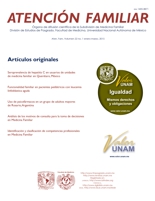Seroprevalence of Hepatitis C in Family Medicine Units Users in Queretaro, Mexico
Main Article Content
Abstract
Objective: determine the seroprevalence of the Hepatitis C Virus (hcv), in users of three Family Medicine Units (fmu) in Queretaro, Mexico. Methods: cross-sectional, population-based descriptive study, approved by a Committee of Investigation. Non-randomized sample by quota and conglomerates. Study variables: seroprevalence of hcv; history of blood transfusions and seroprevalent hcv family members; use of intravenous drugs, tattoos or piercings; be a worker in health institutions and risky sexual practices. It was obtained, with a prior informed consent, a venous sample of users of the fmu numbers 6, 9 and 16 of the Mexican Institute of Social Security (imss) of Queretaro, Mexico. It was determined Ac anti-hcv by third generation of Enzyme-Linked ImmunoSorbent Assay (elisa) and it was applied a survey for the socio-demographic and epidemiological data. It was used descriptive statistics with support of the spss v15 program. Results: from 7 022 volunteers, the average age was 40.5 ±12. 5 years, there were 62 seropositive to anti-hvc (seroprevalence of 0.882% (ic 95% 0.663-1.101). In the Group of 58-62 years there was higher prevalence (0.270). The most important antecedent was blood transfusion prior to 1995 (0.669). Conclusions: the seroprevalence of hcv in open population is higher than the national average reported in blood donors; blood transfusion was the most frequent antecedent for hepatitis C.
Downloads
Download data is not yet available.
Article Details
How to Cite
Santiago-Torres, L. E., Camacho-Calderón, N., & Gregorio Guerrero-Rodríguez, G. (2015). Seroprevalence of Hepatitis C in Family Medicine Units Users in Queretaro, Mexico. Atención Familiar, 22(1). https://doi.org/10.22201/facmed.14058871p.2015.1.47976
